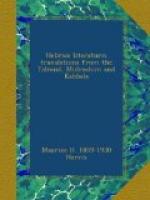1. “Gematria.” This rule depends on the numerical value of each letter in the alphabet. The application of this rule in the solution of a disputed point is often such as to show quite as much absurdity as ingenuity. To make the subject still more clear, let us assume that a standard numerical value is attached to each letter in the English alphabet. A has the value of 1, B 2, C 3, D 4, E 5, F 6, G 7, H 8, I 9, J 10, K 20, L 30, M 40, N 50, O 60, P 70, Q 80, R 90, S 100, T 200, U 300, V 400, W 500, X 1000, Y 10,000, Z 100,000. And let us now assume a point in dispute in order to illustrate how it is solved by Gematria. Suppose that the subject of discussion is the comparative superiority of the Hebrew and English languages, and Hugo and Baruch are the disputants. The former, being a Hebrew, holds that the Hebrew is superior to the English, “because,” says he, “the numerical value of the letters that form the word Hebrew is 610; whereas the numerical value of English is only 209.” The latter, being an Englishman, holds, of course, exactly the contrary opinion, and argues as follows: “All the learned world must admit that the English is a living language, but not so the Hebrew; and as it is written (Eccles. ix. 4) that ’A living dog is better than a dead lion,’ I therefore maintain that the English is superior to the Hebrew.” The dispute was referred to an Oxford authority for decision, and a certain learned doctor decided it by—
2. “Notricon.” This consists in forming a decisive sentence composed of words whose initial letters are in a given word; for instance, Hebrew:—“Hugo’s excels Baruch’s reasoning every way.” English:—“English no good language, is scarcely harmonious;” but Hebrew:—“Holy, elegant, brilliant, resonant, eliciting wonder!” This is a fair specimen of how to get at the secret sense of a word by the rule of “Notricon,” and now we will proceed to explain—
3. “Temurah.” This means permutation, or a change of the letters of the alphabet after a regularly adopted system. We know only five such permuted alphabets, but there may be more. The technical names of these five alphabets are: “Atbash,” “Atbach,” “Albam,” “Aiakbechar,” and “Tashrak.” We will try to explain the first permuted alphabet only, as a mere specimen, for the general reader is not quite prepared to comprehend the rest, and a hint for the scholar is sufficient.
Here let the reader observe that as the letters of the English alphabet are more numerous and differently designated and arranged than those of the Hebrew, the “Atbash” of the Hebrew must necessarily become “Azby” in English. If now we write on one line and in regular order the first half of the alphabet, and the other half on the second line, but in reversed order, thus:—




